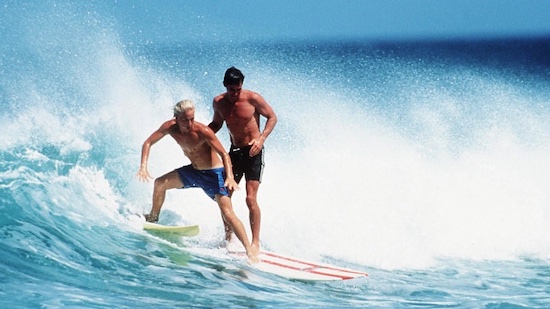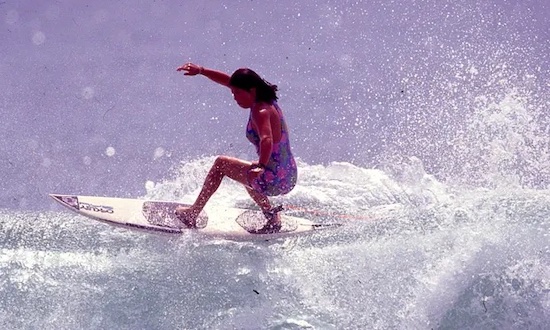In a basement, or garage, one of those hatches where penniless surfers shelter, a teenage runaway, tresses flowing, slumbers on a mattress with her beloved surfboard. On another mattress, humped by the wall, is her newborn baby. It’s one all-too-brief but fascinating glimpse of the reality of feminine surfing in Christopher Nelius’ Girls Can’t Surf. The film uses videos from the ‘80s and ‘90s to tell the inside story of a group of chronically underpaid and humiliated pro athletes. They push for decades for women’s surfing to be fairly respected, until equal pay is finally instituted in 2019.
Surf movies have traditionally suppressed the softer, stinkier elements of the female body. Superficially, with its brash graphics and synth-guitar rock, Girls Can’t Surf aligns itself with the post-punk, rebellious spirit of feminist queer films like 2021’s Rebel Dykes and the comix-and-pop-video fuck-you attitudes of today’s surf films. Surfing has long been appropriated by white rich-kid poseurs, a travesty satirised in 1987’s Surf Nazis Must Die, a camp, John Waters-esque apocalyptic B-movie by Peter George. Liberal ecological evangelists, stoner surfers and self-appointed “custodians of the ocean” types also fuel the first season of Rose Byrne’s ‘80s-set TV series Physical. A pop-video style punks up the recent documentary Riss, a puff-piece by world champion and Olympian Carissa Kainani Moore, probably the current women’s No.1. And one of the worst examples of surf’s counter-cultural posings is Modern Collective from 2009, a pseudo-provocative surf film as bone-headed as its six “heroes”, who bewilderingly contemplate Pink Floyd-esque prisms, while one’s girlfriend waits for him in her bikini on the sands.
Such stylings betray the difficulty of capturing surfing’s substance. How do you communicate the effervescent peace of awe? Mounting a speeding swell, as those of us who attempt surfing know, can be a rough business, let alone with a camera. Yet the crash of visual drama – the tiny, persistent human navigating the rolling grandeur of gigantic waves, scored by bombastic guitar solos – too often distances us from the physical and emotional experience of surfing. A few frames can be glorious, as when surfer-photographers like George Greengough (in 1973’s seminal Crystal Voyager) rides with you through barrel waves by strapping a waterproof camera to himself. But too many and it becomes surf porn: another mountainous wave, another white man “popping up’ (the technical term for standing on a board) again and again.
Surfing films have for too long been about the male gaze and its supposed addiction to physical and sexual thrills. In Kathryn Bigelow’s lumbering Point Break, an FBI agent (Keanu Reeves) pursues surfing bank robbers (led by Patrick Swayze, spouting such spiritualisms as are parodied in Surf Nazis Must Die). Proudly a woman-in-a-man’s-world director, Bigelow’s script scorns characterisation, the splashy plot and acrobatic camera flexing until it’s all flat water. She ogles Keanu’s female instructor (and, predictably, love interest) like a man, lingering creepily on her body while she gets dressed.
It was a novelty girl surfer, Gidget, who stormed American theatres in 1959, four years before The Beach Boys released ‘Surfin’ U.S.A.’. Sandra Dee plays a squealingly infantile blonde who earns the admiration of her oversexed brothers of the waves. By the ‘90s, when some of the women in Girls Can’t Surf were sleeping in their board bags on penniless tours, the grand-daddy pioneer of surf movies, Bruce Brown, was still chuckling like an embarrassing uncle about “little girls…. and big girls” who surf, in Endless Summer II, the sequel to his iconic Endless Summer, the most successful surfing documentary of all-time.

There’s nothing cute about the trailblazers – Jodie Cooper, Frieda Zamba, Lisa Andersen, Layne Beachley and more – in Girls Can’t Surf, written with Julie-Ann De Ruvo. They relive past challenges like soldiers in a pub, Cooper remembering taking a giant wave like an enema, “a bayonet up my bum”, because of the revealing swimsuit she was expected to wear.
These characters bring a rugged candour to a unshowy, solid and largely enjoyable talking-head documentary that punches hard on corporate chauvinism and surfing associations’ manipulations of sportswomen coerced to wear tit-slipping swimsuits. Nelius’ rejection of the genre’s majestic pretensions could, however, be more emotionally textured. In an industry relying on big brand sponsorship, it’s refreshing to hear from lesbians, a recovering addict, and a surfer living with disability. But the gritty problems of poverty, domestic violence, anorexia and homophobia are smoothed over too swiftly by the film’s sun-soaked archival footage from a 1980s defined by neon colours, hairdos and sexism. Nonetheless, the women’s earthy pragmatism offers a satisfying antidote to the vapid romanticism of the stereotypical lofty male surfer.
Most interestingly, the film resists fake sisterhood. There’s a hearty – and professional – rivalry, but a relative silence on the women’s relationships today, or negative self-comparison. There’s not overmuch political correctness, either, as when Cooper skits the Eastern Bloc heritage of feted American champion Frieda Zamba, nicknamed Robotron by her envious competitors. Zemba’s response? “You can’t hang out with the girls too much. They’re going to find out your weaknesses and crush ya.”
Certainly, these women, all white and Australian, South African and American, seem to embody a time when you acted first and never reflected later, exhibiting that stereotypically masculine virtue of repression. Many, like Zemba, were self-confessed “tomboys”. Pam Burridge passed as a boy, “flying under the radar.” Maybe there were fewer words, back then, for the horror of being, like Cooper, invasively outed by your straight roomies. Certainly, the legendary Wendy Botha, who posed for the cover of the 1992 Australian Playboy, sees no irony in being “proud” of her femininity by taking her kit off for wankers. Growly, jowly and tons of fun, Botha revels in her “warm, fuzzy feeling” at the fails, these days, of her younger counterparts.
It’s good to hear underdog champion Pauline Menczer talk of stabbing down her arthritically-clawed hands when competing, but the link between a winning mentality and pain is insufficiently mined. Nelius glosses over Layne Bleachley’s suicidal depression, as the adopted child of a raped mother (discussed elsewhere). Nor is there a hint of surfing transcendentalism, easy to spoof but radical to experience.
Traditionally, the genre treats the sublime as a male thing. The paradisiacal, drop-out tone was set by Endless Summer and its sequel Endless Summer II. Fronted by the later notorious acid-tripper Mike Tynson, without a bong or a bottle in sight, Brown and co’s super-blonde, peacenik mission was to quit everyday jobs and the Vietnam draft and follow summer, and surfing, around the world. With laidback Californian sarcasm, Brown, in Endless Summer I & II, narrates the antics of his doofus heroes. They swim through alligator-infested waters or sneaking surfboards past slavering Alaskan bears, paddling and pranking in an unintended homo-erotic haze. Made on a shoestring budget, the mouth-watering turquoise shots of Brown’s first film made $20 million. That’s a documentary phenomenon that testifies to surfing’s sensational counter-cultural myth.
Brown’s warm visual rhetoric of mystical manhood – orange skies, white discs of sun, a single, wave-tossed bark and the silhouette of two semi-naked men – is recast with contemporary panache in the black and white seascapes of Rick Wall’s Satori in 2018. Here, the men of the white South African community who ride the giant killer wave, Dungeons, speak with a sober sensitivity that, for genuine emotion, beats anything you’ll hear in Girls Can’t Surf. The roiling ocean appears like a shuddering beast, the men clinging to it like fleas. These are the fabled quiet guys of local lore, whose heroisms, such as paddleboarding the Atlantic solo for three months, are undertaken for personal life lessons “on the edge”. “Satori”, in Japanese, refers to instant awakening, limitless immersion in the now. The men talk euphorically of feeling “like prey”: some of them look high as fuck. There are some spangly-eyed Moby Dick-style soliloquies. One snaggle-toothed, dreadlocked character ascribes any surfer’s luck in discovering perfect conditions to “his karma, his love of the ocean”.
Films like the thoughtful Maui-set Hana Surf Girls from 2010, and 2007’s touching, São Tomé-set The Lost Wave have portrayed surfing in other cultures, albeit not purely from a non-white point of view. A common thread is the surfer’s encounter with the vital force underlying life, or to put it in Polynesian terms, like this year’s Hono, “mana”. It’s understandable that Girls Can’t Surf steers clear of the male surfing sublime, but it entirely bypasses the sensory encounter with the sea available to all surfers, even bumblers, like me. I was intrigued by Rick Wall’s group attesting to the growling sound of “pure motion” and “at the same time, the buzz of silence.” While it’s good to hear directly from women champions, I prefer the visceral, trippiness of films like Greengough’s Crystal Voyager. With bold, bumpy ‘70s editing that gives you ocean vertigo, the film sucks you through a hushed, circular window into the barrel of a wave. Greengough’s drawl, too, has an irresistibly narcotic effect. Something ancient reverberates in one’s brain, when he says, “It’s a time warp when you’re in the wave. The only reality is what’s happening right then.”


